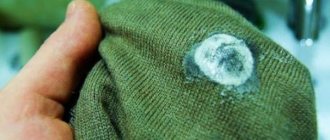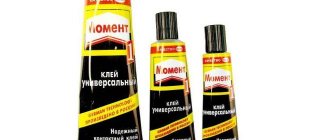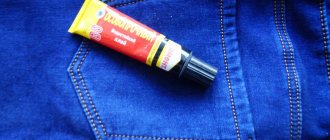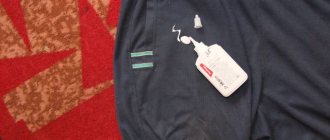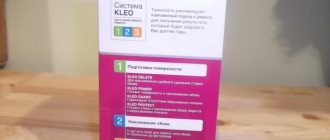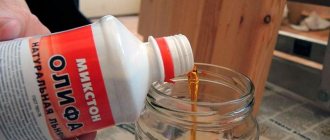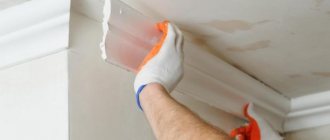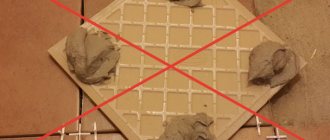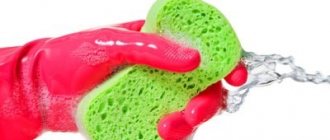General recommendations
The most important rule: try to clean clothes from glue immediately. Old traces are much more difficult to remove.
- Any glue that gets on clothing should be blotted immediately with a napkin, paper towel or soft cloth. Remove any residue with a toothpick, knife or nail file. You need to work with them carefully to avoid cutting the fabric or tightening it.
- Check the effect of the selected substances on an inconspicuous area of the product (collar on the reverse side, seams). Fabric fibers can be damaged by chemicals.
- If it is not possible to remove glue from clothing immediately, it is better to moisten the stained part with water, this will prevent it from drying out.
- You should resort to mechanical removal of glue (with the exception of Titanium) only after its pre-treatment (freezing, heating, applying alcohol, acetone, etc.)
- Before using one or another method of removing adhesive stains, you need to familiarize yourself with the recommendations for caring for the material.
The constituent components of the glue determine its properties: drying time, water and moisture resistance, viscosity and others. These qualities help determine how quickly and without much effort it will be possible to clean things from it.
Fighting silicone glue
Silicone adhesive is popular in the construction industry, handicrafts, and household repairs. A fresh blot quickly turns into an elastic film. To get rid of it, stretch the fabric, which removes the dirt. Pre-freezing the item helps remove glue from clothing. The adhesive blot becomes brittle and can then be easily removed.
A remover designed for polyurethane foam has a good removing effect for silicone adhesive composition. They saturate the stain, wait until it dries, and then simply remove the film. Vegetable oil will also help. A cotton pad soaked in it is kept on the adhesive mark for several minutes. After making sure that the glue has dissolved, the product is washed.
When determining how to clean clothes from silicone-based glue, which is strongly absorbed into the fibers, use diluted vinegar, soaking the product in it. After 30 minutes, wipe off the mark with a rag. You can also remove the stain using vodka, which is recommended to be poured onto the damaged area, and then rub the adhesive trace with a brush from the edges to the middle. With this effect, the silicone rolls off and is easily removed.
Getting rid of superglue stains
It is characterized by rapid drying and reliable bonding of almost all surfaces. Stains or excess stains can be removed using anti-glue, strong solvents, vinegar, citric acid, nail polish remover, freezing and heating.
Anti-glue, refined gasoline, paint thinners
Anti-glue can be purchased at building materials stores. Apply 1-2 drops to glue marks and after 5-10 minutes wipe with a paper napkin.
White spirit, acetone, and kerosene are used on non-colored cotton and linen fabrics. Their use on wool, velvet, silk and synthetic fabrics is prohibited. Thin synthetics can dissolve under their influence.
- Soak a soft cloth with one of the selected substances.
- Wipe off dirt with it.
- Wait 20-30 minutes.
- Wash the item as usual.
It is allowed to repeat the procedure no more than 2-3 times for an old stain. If most of the dirt has been removed, it is better to try to wash off the glue by hand. This will prevent tissue damage.
Note: Acetone is effective, but can sometimes leave yellow stains.
Vinegar
Suitable for removing glue stains even from delicate fabrics, but is contraindicated for denim.
- Dilute one tablespoon of vinegar in warm water (one glass).
- Moisten a soft cloth in the resulting solution and place it on the adhesive trace.
- After 20-30 minutes, remove the dissolved glue with a napkin. You can soak the product in this solution for half an hour.
- Then wash as usual.
Nail polish remover/acrylic nail softener
- Soak a soft cloth with one of the selected products.
- Treat the part of the item stained with superglue.
- After 20-30 minutes, clean the dirt with the hard side of a dishwashing sponge.
- Wash the item as usual.
When working with delicate fabrics, it is better to use an acetone-free liquid.
Dishwashing liquid will help get rid of greasy stains that may remain after removing the adhesive residue.
Exposure to high or low temperatures
There are two effective ways:
- From the wrong side of the product, through gauze or soft fabric, apply a hot iron to the superglue mark for a split second. After half a minute, apply the iron again. Repeat two to three times. Remove remaining adhesive mechanically - rub with your hands, a toothbrush or the hard side of a sponge.
- Keep the soiled clothes in the freezer for 1-1.5 hours. Pull out and rub the glue stain with your hands or a toothbrush with medium-hard bristles. When frozen, the glue crumbles and easily comes off the fabric. Wash clothes. It will take several washes to completely remove the stain. The freezing method is also applicable for delicate fabrics (organza, silk, viscose).
Citric acid, dimexide, white, powder
Here are a few more ways to remove superglue stains from clothes:
- Dissolve citric acid (20 g) in warm water (half a glass). Apply the resulting solution to the adhesive marks with a soft cloth. After 5-10 minutes, rub the stained area with a hard sponge and wash the item.
- The nail file is suitable for removing glue from suede or leather products. It is enough to move it with light circular movements over the contaminated surface.
- Dimexide (a medicine for the treatment of bruises and purulent wounds sold in pharmacies) allows you to get rid of glue stains from any type of fabric. Use a soft cloth soaked in a solution of dimexide (2 tablespoons) and room temperature water (half a glass) to wipe the contaminated areas. After 10-15 minutes, wash the item.
- Whiteness applies to white things. Apply the product to the adhesive stain and rub it with a cotton cloth. The sponge will not work; its small fibers will cling to the glue.
How to remove glue from clothes
Use the means at hand to remove adhesive stains from clothes or shoes. The effect of them is sometimes even better than that of chemical stain removers. Use available products with caution; they can harm delicate fabrics.
Ammonia
Softens glue on clothes. Moisten a cotton swab with ammonia and apply to the stain. After half an hour, scrape off the remaining stains with a knife.
Cold
Remove adhesive residues from thin fabrics by cold. The item is placed in the freezer so that the contaminated area is exposed. After an hour, the glue will harden and it will be easier to peel off. Shake off crumbs or remove with tweezers.
To watch a video about the method:
Warm
The heat will warm up the dried glue, making it easier to remove. The contaminated area of clothing is covered on both sides with napkins and ironed with a hot iron. You need to touch the iron quickly so that the napkins do not stick. Then scrape off the softened mass with a knife.
Soap and water
This method requires preparing a soap solution. Dissolve laundry soap shavings in very hot water - 100 grams per two liters. Place the soiled item and leave for half an hour. When the water has cooled slightly, scrub the contaminated area vigorously with soap.
Then wash the clothes as usual. It will take 2-3 such procedures to remove marks.
Fat
Margarine or butter will help remove fresh small adhesive stains. Rub a stick of oil onto the stain, then wash in hot water. But fat also leaves marks on clothes, so using this method is not recommended.
Acetone
It can only be used on thick clothing - pants, jackets. The glue trace is filled with acetone and left for an hour. Then the softened residues are removed with a knife and napkins.
Watch a video about this method:
White
Used on undyed fabric. Rub the product into the contaminated area and allow to dry. The remaining glue is scraped off with a knife, and the item is then washed.
Petrol
Removes fresh dirt - moisten a sponge with gasoline and rub clothes. Suitable for cleaning natural materials. Colored material may become discolored.
"Dimexide"
This is a medicine that is sold in a pharmacy. Cotton swabs are soaked in the solution and covered on both sides of the contaminated area. After 10 minutes you need to wipe off the residue. Repeat the procedure 2-3 times.
"White Spirit"
The solvent is used to clean light-colored clothing made from natural materials. Moisten a cotton swab with the product, apply it to the stain, or immediately pour it over the stained area. After an hour, remove the remaining glue with a knife.
Vinegar
Suitable for cleaning natural materials. Take a tablespoon of vinegar per glass of water. Soak the contaminated area generously with the solution. After 15 minutes, rub the stain and rinse with cold water.
Anticlean
The product is designed specifically for removing superglue. It is applied pointwise to the dirt, after 15 minutes the residue is removed with a napkin.
Lemon acid
Copes with stationery or wallpaper glue. Dilute a spoonful of citric acid in half a glass of water. Soak the stained area with the solution and wash the clothes after half an hour.
Soda
Soda solution is used together with soap or powder. Removes traces of stationery or wallpaper glue. Clothes are soaked in the solution for three hours and then washed.
See how to make the solution correctly:
Removing traces of silicate or wallpaper glue
Silicate or wallpaper glue can be removed from clothing using detergents such as:
Soda and laundry soap
- Add two tablespoons of baking soda to one liter of warm water.
- Wash the glue stain well with regular laundry soap.
- Dip the soaped part of the clothing into the soda solution and leave for 40-50 minutes.
- Wash by hand or machine.
For suede items you need to use a special shampoo or soap.
Washing powder
- Dissolve 200 g of powder in 4 liters of warm water.
- Leave the soiled item in this solution for 3 hours.
- Afterwards, squeeze it well and try to remove the dirt with the hard side of a sponge or a medium-hard toothbrush.
Or rub the stained area with laundry soap and soak for 4-6 hours in warm water. After washing.
Cleaning silicate glue
Silicate glue, or "liquid glass", is used to glue the paper. When it gets on clothing, the composition instantly saturates the fibers. There are several ways to remove glue effectively.
Fresh traces can be removed using the following algorithm:
- Warm water is poured into a basin and the damaged product is soaked for four hours.
- Lather the stain generously with laundry soap.
- On thick textiles, the contaminated area is additionally scrubbed with a brush.
- Wash the item thoroughly.
You can remove glue from clothes using baking soda. In a liter of heated water, stir three tablespoons of baking soda and two of detergent (you can rub the fabric with washing soap instead). Before washing, soak the contaminated item in the solution for four hours. Author: Youtube channel NanaSweetHome.
Before removing glue from suede clothing, make sure the detergent is suitable for the material. Information is on the label.
What to do with a PVA glue stain
It is easy to remove fresh traces of PVA glue from clothes by washing with laundry soap. Or place the soiled part of clothing that is not afraid of high temperatures, with the wrong side under running hot water. After 20-30 minutes the glue will come off the fabric.
An old stain on cotton, linen or denim fabrics will go away if you wipe it with a cotton cloth soaked in alcohol.
A stain from PVA glue on a suede product must first be held over steam for 5-7 minutes, and then carefully remove the dirt with a paper towel or napkin soaked in ammonia.
The freezing method is also suitable for delicate fabrics. Place the clothes in the bag in the freezer for 1-1.5 hours. Then carefully remove the glue from the material with your hands, which has become brittle from the cold.
First steps with a fresh spot of glue
It is easier to remove a fresh glue stain from clothes. It has not yet penetrated the structure of the fabric, it is on the surface. It needs 1–2 hours to dry, and if we are talking about superglue, then no more than 30 minutes. The worst thing is if the substance gets on nylon or silk. These fabrics are thin, sensitive, and the glue leaves a burn on them.
First steps when adhesive gets on fabric:
- carefully remove the item so that the drops do not spread;
- place the item on a hard surface;
- Use a paper towel to carefully remove any adhesive drops;
- if the material is dense, the drops can be removed with the back of a knife blade;
- Rinse clothes thoroughly with running water.
To completely destroy adhesive traces, you need to use a stain remover or improvised means. We will talk about them further.
What will help dissolve epoxy glue?
Alcohol
- Carefully remove large traces of glue with a knife, spoon or nail file.
- Wipe the dried stain with a rag or cotton-gauze swab soaked in alcohol.
Pharmacy turpentine
- Apply to stains and leave for 7-10 minutes.
- Then use a soft bristle brush to scrub the glue stain.
- Wash the item with powder and add fabric softener, which will help get rid of the characteristic pungent odor of turpentine.
- An old stain can be removed with a mixture of alcohol (a teaspoon) + pharmaceutical turpentine (a teaspoon). Also, first apply the solution to the stain, wait 5-8 minutes, and gently rub with a brush.
Ironing
Place a plain cloth or paper towel under the stain on the wrong side of the product. Iron the stained area from the wrong side. The glue will melt and be absorbed into the substrate. Remove any remaining faint stains by wiping with a sponge soaked in alcohol. Next wash on standard cycle.
Fighting other types of glue
Recommendations on selecting suitable products will help you effectively clean clothes from specific types of glue without damaging the item.
- Casein adhesive material is lubricated with glycerin, preheated in a water bath. After two hours, pour half a teaspoon of ammonia into a liter of cool water, and with this solution, use a sponge to wash off any remaining dirt. Instead of glycerin, use ammonia. It is applied to the mark being treated. If the fabric is thick, additionally wipe with a brush. After removing stains, items are washed.
- To remove drops from nitrocellulose glue, soak a cotton swab in acetone and treat the contaminated area. Then moisten the stains with gasoline. Carefully remove the remaining particles with a paper napkin and add talc. After half an hour, shake off the remains and wash the item. This technique is not used for acetate silk.
- To remove marks left on clothing after contact with hot-melt glue, lay the item on a towel. Light cotton scraps are placed on the bottom and top of the fabric and a heated iron is applied. Under the influence of heat, the adhesive melts and is absorbed into the underlying fabric pieces. They are changed as needed. You can put the product in the freezer and then remove the brittle blot using the blunt side of a knife or your fingers.
- Stains from textile adhesive are removed using aggressive compounds - solvents, gasoline, which are not suitable for thin and artificial textiles.
- A blot of rubber vegetable glue is moistened with gasoline, a thin layer of talc is poured on top, and left for four hours before washing. Use this method with caution on colored fabrics and carry out mandatory preliminary testing.
It is recommended to treat the stains remaining after removing the adhesive label with gauze soaked in acetone. An eraser is used for suede products.
If the plant adhesive contains resins or starch, to remove it, mix two tablespoons of alcohol (95%) with five tablespoons of filtered water. Pour in 20 grams of soda ash. Soak a cotton pad in the resulting solution and carefully treat the stain. When the glue dissolves, the product is washed.
If an item becomes dirty from contact with an adhesive anti-rodent trap, then the dense items are treated with gasoline. Thin textiles are treated with vegetable oil, which is used to moisten the mark. After five minutes, wash off with dishwashing gel and wash.
Hot melt adhesive
Isopropyl alcohol (isopropanol) is applied to the stain with a cotton swab. The glue softens, allowing it to be separated from the fabric. Also suitable methods:
- freezing in the freezer. At low temperatures, hot-melt glue becomes brittle and can be scraped off with a spoon or sandwich knife.
- heating with an iron. Place a cotton cloth on the stained area and iron it without steam for 7-15 seconds. Lifting the piece, you can see that the glue has begun to transfer to it. Repeat ironing until it is completely transferred to the substrate.
What do you need to know if you get dirty with glue?
If you get into a situation where adhesive gets on your clothes, then don’t panic and throw away your favorite item. It is recommended to calm down and act according to the following plan:
The first thing you need to do is to remove any remaining glue from your clothes with the utmost care using a clean napkin, but so as not to stain or smear the glue stain even more.
After this, using a regular knife, it is recommended to remove any remaining glue from the surface of the clothing. Then we determine the type of fabric texture and glue. It is important to remember that dried and old glue stains are much more difficult to remove than fresh stains. Once you have selected a specific glue stain remover, it is important to first test on an inconspicuous area of the affected clothing to prevent permanent damage to the fabric texture, discoloration or deformation. When removing glue stains, it is recommended to place a thick fabric material or cardboard paper under the treatment fabric to prevent damage to the surface of the table or other furniture used to treat damaged clothing. When you have completed removing the unfortunate stain, it is recommended to wash the treated item of clothing in the usual way.
Titanium
This glue can be removed from the fabric by mechanical action.
- Place the stained area on a hard surface.
- Place gauze or paper towel over the glue stain.
- Tap the cured glue with the handle of a knife or a hammer.
- Remove the remains with a nail file.
Getting rid of glue from fabric at home is quite easy and safe. But when choosing a method, it is necessary to take into account the type of material and brand of glue. If the methods turned out to be ineffective or there is no confidence in the safety of the chosen method, then you should contact a dry cleaner.
How to remove glue from clothes: general rules
You can quickly get rid of glue on clothes if the stain is fresh. Over time, the glue will penetrate into the fibers, and dealing with the stain will become more problematic. A fresh blot is immediately blotted with a paper napkin, without moving it, so as not to increase the area of contamination.
You should select the appropriate cleaning method and means, taking into account the type of fabric and type of glue.
The selected composition is checked for the degree of impact on the fibers. Before washing off the glue, apply a small amount of the product to an area that is not visible from the outside. Examine after half an hour. If no negative changes occur, cleansing operations continue.
Superglue on clothes is not a disaster
Superglue or “Second” has increased adhesive ability, dries instantly and requires careful use. Removing it from clothes will not be easy, but it is quite possible.
- A fresh stain should be immediately wiped with purified gasoline.
- You can try to remove dried traces of superglue with preparations for removing nitro paints.
- Soaking damaged clothing in soapy water with washing powder and ammonia has been proven effective. It is necessary to maintain a 3:1 ratio of added components. Then rub the dirt with a brush until it disappears.
- White clothes are cleaned using “Whiteness”. A small portion is applied to the print. All that remains is to lightly rub the stain with a cotton cloth.
- Acetone can save jeans from superglue. However, the product has a negative effect on the dye and it is better to test it first on the inside of the belt.
- The vinegar solution successfully cleans silk and woolen clothing. Things are first soaked and then washed in the usual way.
Advice. Do not apply cotton wool, fleecy cloth, or a brush to a fresh superglue stain. Villi and bristles will stick to the adhesive layer and the situation will become even worse.
- On dense materials, the glue can be removed with a manicure file, pumice stone or a sharp edge.
- The structure of superglue is destroyed when frozen. It is enough to pack the item in a bag and put it in the freezer for 2-3 hours. After removal, carefully remove frozen drops with a sharp object. Cold exposure should not be used on thin fabrics.
How to remove glue
Since different types have different chemical compositions, the means to clean them also need to vary. Let's take a closer look:
Super glue is one of the most effective, but also difficult to remove. Acetone is considered a common removal agent (including cosmetic materials for nail polish remover). Important: you should let the super glue dry thoroughly and only then start cleaning. You need to generously wet the adhesive stain with acetone and leave for at least 1 hour. After soaking, wipe the contaminated area with a hard sponge or brush (a toothbrush will also work), and then rinse with water. If after 1 time the stain does not go away, repeat the procedure until the desired result. If there is no result from using acetone, it is recommended to use the drug Dimexide (dimethyl sulfoxide), which is sold in pharmacies without a prescription. Glue Moment cannot be called a second, but it sets quickly enough. Therefore, the main condition for qualitatively getting rid of its traces is speed. If you don’t have a special Anti-Glue on hand (sold in hardware stores), you should try gasoline or acetone, which successfully dissolve the glue components. Wet the sponge and thoroughly wipe the dirty area.
You can use white spirit, but this liquid is aggressive, so it must be used carefully. For example, you should not clean the surface of a pine table or chiffon dress with white spirit. PVA is removed with vinegar or alcohol
First, you need to thoroughly wipe the dirty area with a brush dipped in one of the liquids, and then immerse it in a soap solution for several hours (it is better to use laundry soap). Wash in washing machine as usual. Wood glue can be effectively cleaned with acetone or nail polish remover. You need to wipe the stain with a sponge until it disappears. The stationery is easily removed in a simple way - washing with water will help. It is important to do this before the adhesive completely dries. If the area of contamination is large, for example, glue has spilled, you need to collect it with a rag and then rinse the area with water until clean. Textile glue is used for gluing rhinestones and appliques. To clean things from traces of it, it is recommended to use acetone, gasoline, and white spirit. It is also worth using professional products, since this material is complex in composition and may not be amenable to home dry cleaning. Hot is often used in a heat gun, so it’s easy to get dirty. Mostly trousers and jeans suffer. It is removed using temperature. The best way is to freeze it in the freezer for 5-6 hours, and after the item is thoroughly frozen, simply crumble the drops with your hands or a hammer.
Do you wash your shoes in the machine?
Oh yes! No
Wallpaper glue can be easily cleaned with water and laundry soap. The item is soaped and left for 5-6 hours, then washed. Rubber adhesive is made from natural rubber. To get rid of stains, it is recommended to clean the area with the following solution: 10 g of soda ash, 1 tbsp. l. 95% alcohol, 3 tbsp. l. water. The mixture is thoroughly treated with dirt and subsequently washed off. Silicone glue is the most resistant, so experts advise getting rid of it mechanically (scrape it off with a scraper or cut it off). Silicone responds well to 70% vinegar and 96% alcohol. Pour one of these liquids over the stain, wait until the sealant softens, and remove it with a sharp object. Silicate is removed by immersing the item in this solution for 3-4 hours: take 2 tbsp per 1 liter of water. l. soda and any detergent. Then the clothes are washed. Shoe glue is removed, depending on its composition, either with gasoline or white spirit, or with acetone. In some cases, it is enough to wipe the contaminated area with 5% ammonia.
Help chemical solutions
Unfortunately, not all superglue stains can be removed with a regular knife or hot iron. Some stains are so “tenacious” that you have to resort to chemical solutions and liquids. How to remove super glue from clothes with chemical solutions and liquids?
1Acetone against glue. To remove traces of super glue with acetone, you will need the product itself, a cotton pad, and warm water. You should lay the item stained with glue on a flat surface and place a sheet of cardboard or strong paper under it. Two cotton pads must be well soaked in a pure acetone solution and applied tightly to the material from below and above. Leave for 5-7 minutes, then you can try to scrape off the residue from the fabric
Carefully! Colored items may lose color from an acetone solution.
2White spirit in the fight against superglue stains. How to remove traces of glue with white spirit? To do this, the item can be thoroughly moistened with white spirit in the place where the superglue was spilled and left for several minutes. It is important not to allow the solution to dry on the item, since white spirit evaporates quickly
It is necessary to periodically moisten the stained area with liquid. After this, you can try scraping the glue from the fabric with a convenient object. A more gentle way to remove glue stains is to apply a cloth or cotton pad soaked in white spirit to the stain. For such delicate fabrics as pure silk and cotton, white spirit cannot be used!
3At home, stains can be removed with vinegar. To do this you will need a glass of vinegar 9% and 1 tbsp. l. warm water. Vinegar and water should be diluted in a convenient container. The surface at the site of contamination must be soaked in the prepared solution for 10-15 minutes, and after that you can try to remove the superglue stain by scraping it from the fabric or removing it with tweezers. This method of removing stains is not suitable for synthetic items because it can cause deformation of the fabric in the area where the glue is contaminated.
4How to remove traces of super glue with gasoline? To do this, you will need two rags, which must be thoroughly moistened in gasoline. It is necessary to lay out the clothes on a table or any flat surface and apply rags soaked in gasoline on both sides: top and bottom. After 10 minutes, superglue can be removed from clothing with a convenient object. Clothes should be washed well with powder to get rid of the pungent smell of gasoline and possible stains that remain on the surface after superglue and gasoline.
5Dimexide pharmaceutical solution against superglue stains is an excellent remedy. How to remove super glue stains from clothes with dimexide? To do this, you will need a solution of pharmaceutical dimexide, with which you need to generously moisten cotton pads. The moistened discs should be applied to the stained area on clothing for 10 minutes. After this, you can try to remove any remaining adhesive. If it is difficult to remove, the procedure can be repeated several more times until the glue is completely removed from the clothing. After the procedure, clothes should be washed with powder in warm water.
For options with coarse fibers such as wool, linen, denim, terry, exposure to low or high temperatures will be enough to remove the adhesive. But thin fibers, colored and synthetic fabrics must be handled very carefully, because liquids such as gasoline, vinegar and solvent can damage the fibers, and the item will be damaged not even from stains, but from improper handling of dangerous compounds. By following the instructions above and following the rules for working with substances, you can easily remove the stain, restore the item to its original appearance and continue to wear it.
How to deal with office glue
Mothers of small children and schoolchildren face this problem, because stationery is often used in creativity lessons in schools and kindergartens.
Laundry soap will help remove glue stains. The stained area on the fabric is moistened with water and thoroughly rubbed with soap. Leave to act for 15-20 minutes. For heavy dirt, use a brush. Then wash with detergent.
Ways to wash stains
Practice shows that PVA glue is easiest to remove. If the composition gets on the material, it is necessary to soak the item in warm water as soon as possible, and then treat the contaminated area with any washing powder. The next popular method for removing glue stains involves using denatured alcohol. A small piece of cotton wool or fabric is soaked in the solution, then the stain is thoroughly treated with it. Alcohol can be replaced with vinegar. The item is left for half an hour so that the contaminated area is soaked. Next, the product is soaked in a basin of warm water and the item of clothing is washed completely.
We recommend that you read
If there are traces of silicate glue left on the product, then you need to act as quickly as possible. Experienced housewives soak a piece of clothing in warm water and leave it in this state for 2-3 hours. After this time, the fabric is washed using laundry soap. For effective cleaning, use a sponge or brush of moderate hardness so as not to damage the material of the product. The procedure ends with cleaning the fabric with powder. Laundry detergent is poured strictly into warm water, otherwise it will not be possible to achieve the desired result.
Factory-made products for getting rid of traces of glue
If traditional methods do not help to overcome stains, then you need to buy a special product “Super Moment Anti-Glue”. The manufacturers of this product claim that it can cope with stains from any type of glue. Before use, please note that the composition contains acetone. The presence of this caustic component predicts the use of this drug with extreme caution, especially on dyed and fading fabrics.
HG sticker mark remover is designed to combat marks from adhesive rhinestones and labels. Like the previous product, it should be used carefully and with caution, as it can ruin the color of the material. Another drug, “Glue Cleaner,” is available in the form of a spray and is not as aggressive as the previous representatives. Thanks to this, it can be used on dyed and faded fabrics.
Super glue
Superglue is rightfully considered one of the most difficult types of stains to remove from clothes, linen and other items.
You need to be careful when working with superglue as it is a very corrosive substance that will require some effort to remove.
First you need to pay attention to the manufacturer. Inexpensive gluing products made in China are much easier to remove than blots from a higher quality and more expensive product.
A drop of superglue on jeans, a terry robe, a towel and other dense material can be removed using acetone-containing nail polish remover.
Since acetone, which is part of it, can leave stains on the fabric, it is better to conduct a preliminary “test” on an inconspicuous area.
If a drop gets on silk or woolen material, you can remove the stain as follows:
- Prepare a vinegar solution, keeping the proportions 2:1 (20 ml of vinegar per 40 ml of water).
- The product is soaked in this solution for some time.
- Next, you will need to wash it in warm (but not hot!) water in the usual way.
- Fresh stains are removed with gasoline.
- Dried, old marks from superglue can be removed using paint removers or thinners.
- The freezing method is a good way to remove adhesives. The item of clothing with the stain is placed in the freezer for 1…2 hours. Now, if you intensively rub the area with the blot, the adhesive substance should be destroyed - the glue will begin to crumble and will easily come away from the fabric. Then the clothes will need to be washed.
It is possible that you will not be able to completely get rid of the glue blots the first time, but after several washes it will be practically unnoticeable.
- Citric acid solution. You need to prepare a solution from the following components: 100 ml of water and 20 ml of citric acid. Apply this solution to the stained area of the material, leave for 7...10 minutes, then use a hard sponge to remove marks.
- Scrub. An ordinary body scrub does a good job of removing superglue. You need to apply it to the stained area of clothing and, applying a little force, rub it with a sponge. Then wash off the scrub by rinsing the product with water.
ARTICLE FOR YOU
How and with what to wash and remove felt-tip pen and marker stains from clothes and linen
Vinegar solution for removing stains
Wallpaper
It is not difficult to remove wallpaper glue from clothes. It is diluted with water, which means it will wash off when washing. But sometimes, at the site of the stain, the fabric becomes rough and looks unsightly. Pre-soaking will remove glue from clothes.
The problem area should be soaped and rubbed with your hands. Removing such stains from knitted items - hats, sweaters, scarves - is a little more difficult. You shouldn’t rub the item, but regular washing may not be able to remove the stain the first time. Re-soaking will solve the problem.
Removing stains from Moment glue
Moment brand glue, depending on its purpose and use, is divided into several types. For this reason, the methods for removing it will be somewhat different from each other.
a) “Moment” for footwear
- This substance can be easily removed from any item using nail polish remover. Another similar liquid that does not contain strong corrosive elements and a large volume of acetone will also be suitable.
- If a drop gets on suede material, for example, boots, shoes, or a leather surface, it is very easy to remove it using a nail file, making circular movements with it, without pressing hard in the place where the glue dropped.
b) “Moment” for wallpaper
Easily removed with laundry soap.
- If it gets on the fabric, simply wash it by adding laundry soap to the water.
- If it gets on any surface in the room, wipe it with soapy water.
Removing stains from Moment glue
c) “SuperMoment Ideal”
There will be no serious problems in cleaning things from this substance. There is a specially developed unique product called “SuperMoment Anti-Glue” that will cope with this problem with ease.
General rules for deducing “Moment”
And although the options for removing various types of adhesive compositions differ, for each of them there are certain general rules, which will consist of the following:
- Don't hesitate. As soon as a blot appears, you should immediately try to remove it. Old stains and blots are much more difficult to remove than newly appeared ones.
- A blot on the surface of the fabric should be blotted with a plain napkin.
- If possible, remove as much glue residue as possible with a sharp object, such as a kitchen knife.
- When using removal agents, in order not to spoil the entire thing, you should first check the “reaction” of the matter to them.
ARTICLE FOR YOU
How and with what to wash and remove soy sauce stains from clothes and linen
Cleaning stains from PVA glue
